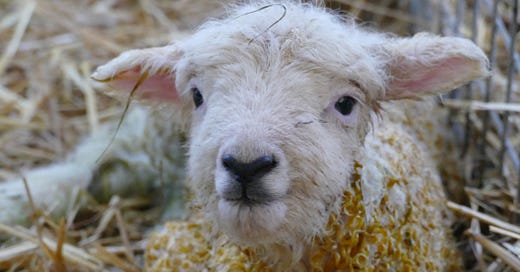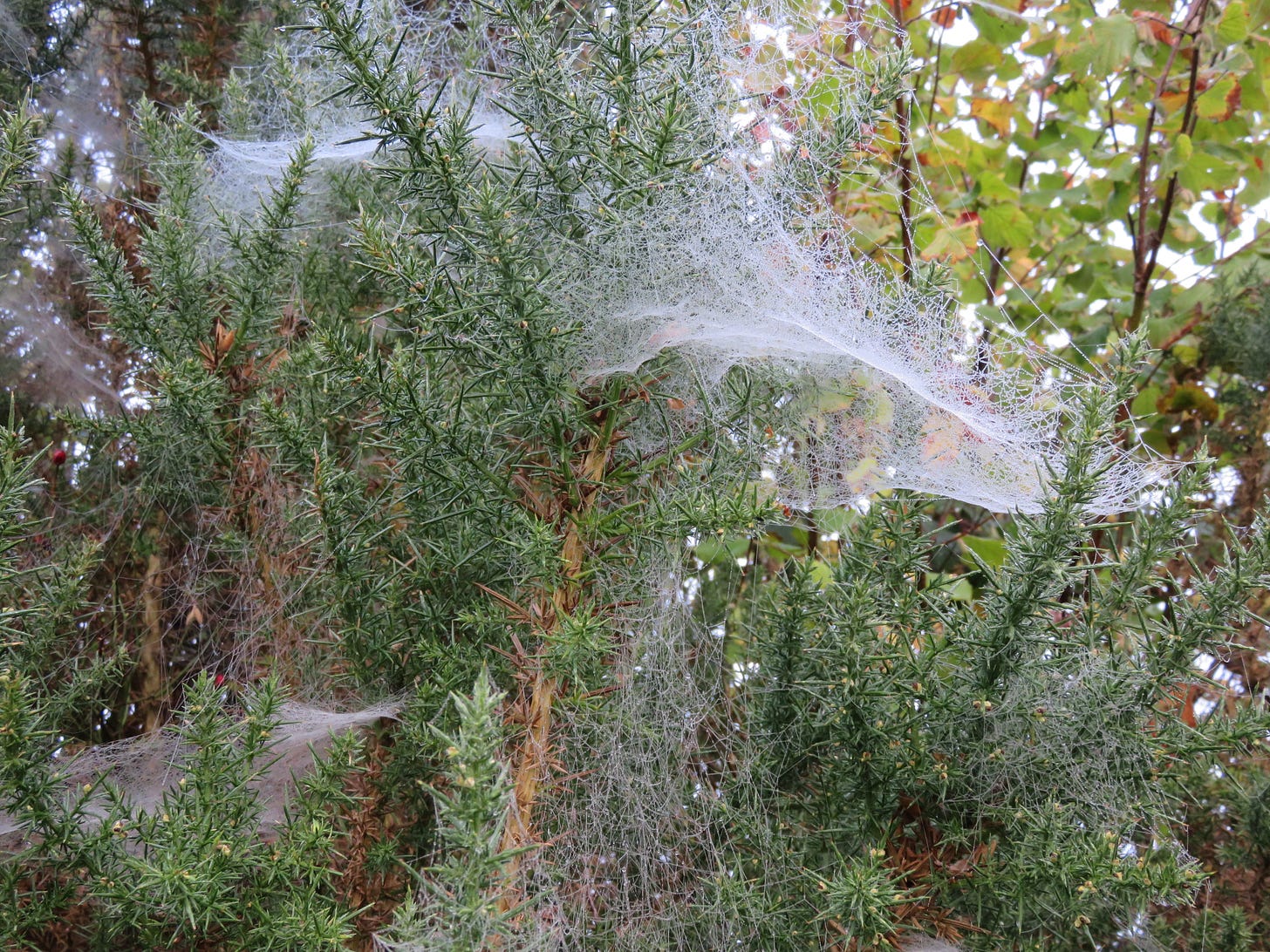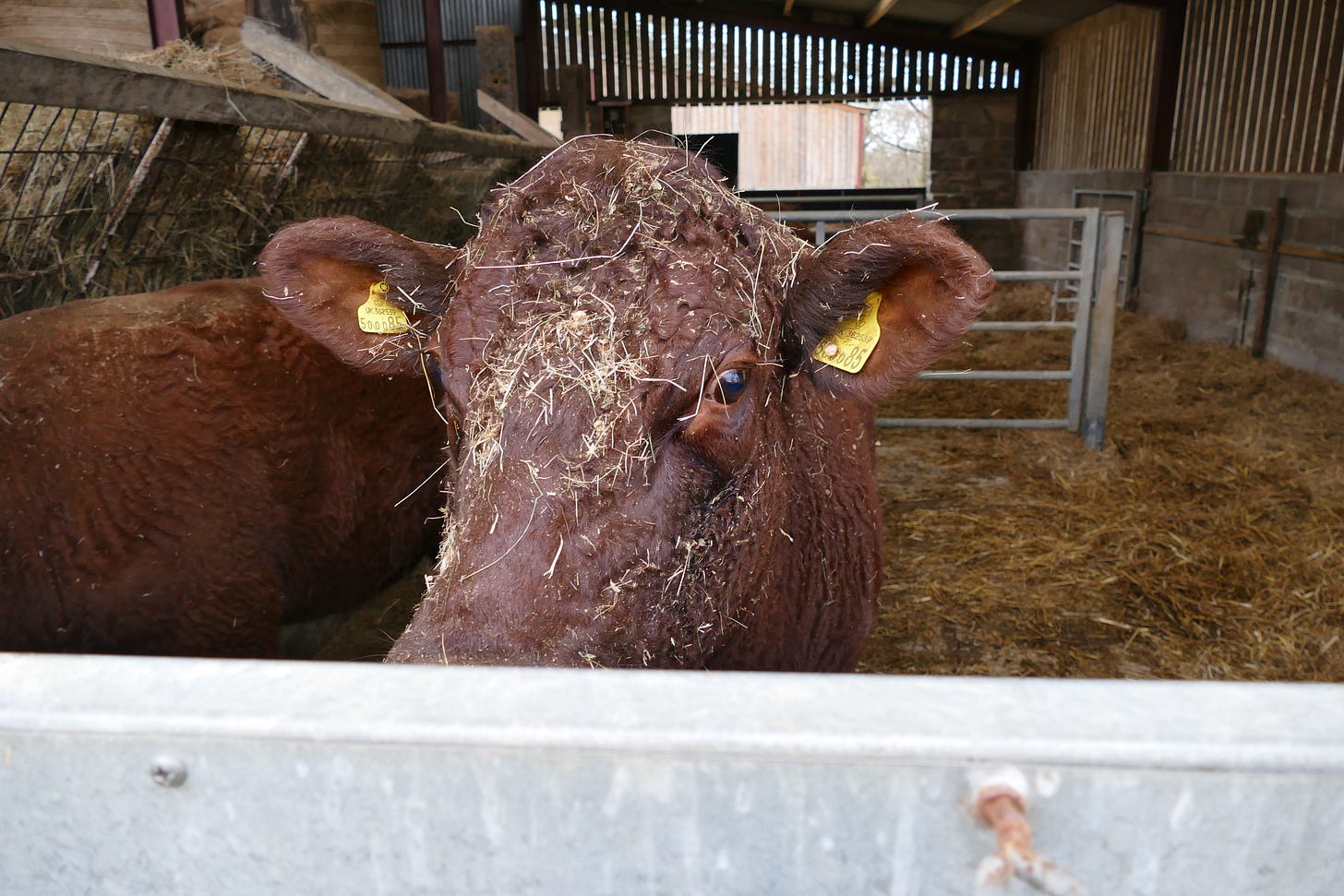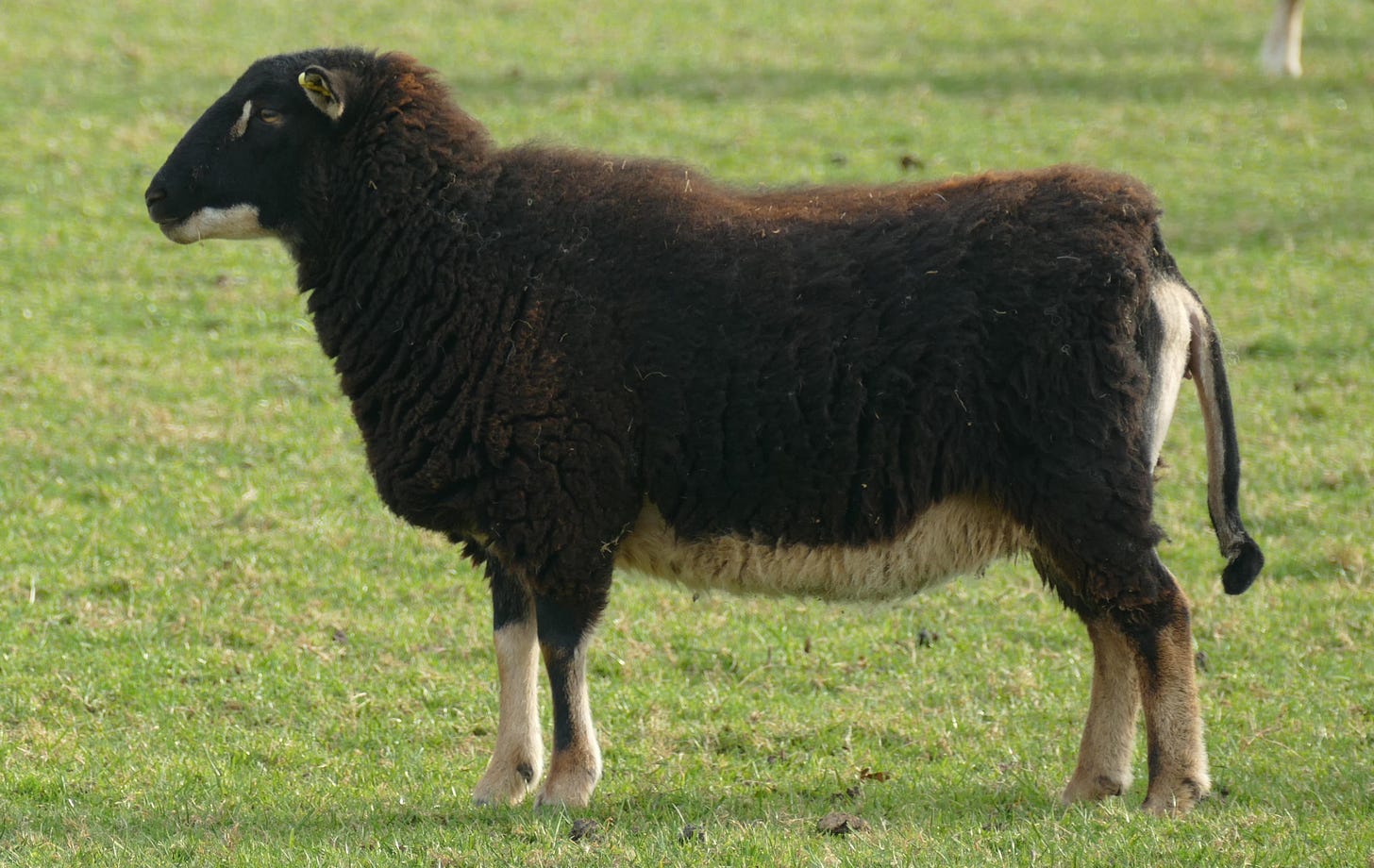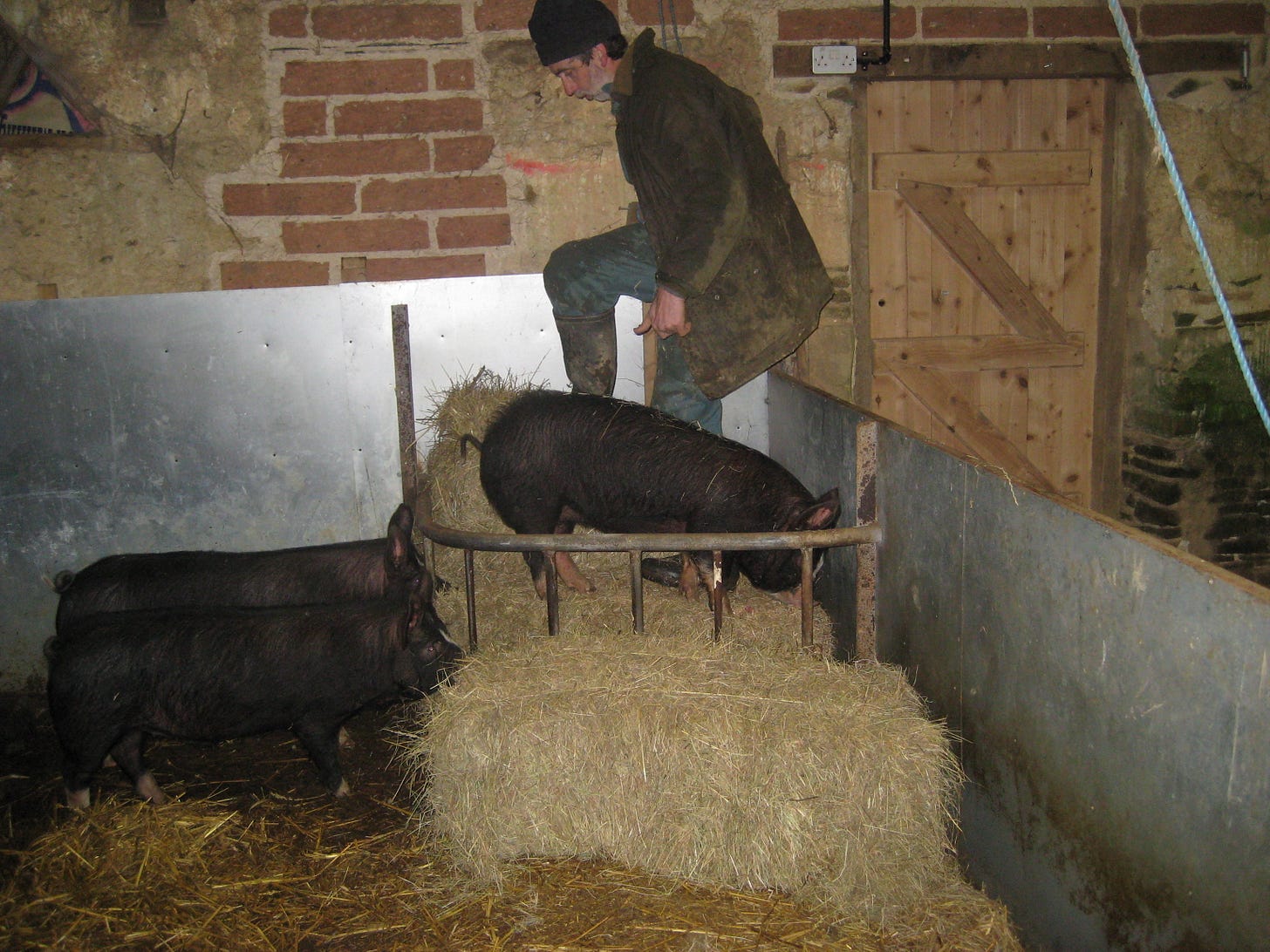Late afternoon Monty and I walk across the fields. We can hear the lambs and ewes bleating to each other in Lower Furze Down, one of the fields we rent out. Harbingers of our own lambing, I enjoy the sight and Monty enjoys the smells of the young lambs. The sun slants low, revealing the never-ending tapestry of cobwebs. As we head off across Lower Down, also known as Seven Acres, my shadow leers up, 25 yards long, legs as long as telegraph poles, reaching the gates many strides before I do; I am a giant with seven acre boots.
Friends are staying and we’re going out for dinner so I’m meant to do a swift evening feed of the cows, but Moonstone has other ideas. Once the hay racks are full and I’ve scattered their seaweed supplement in the mangers, I take the muck fork into the sheds to pick out any dung so that they can settle on clean straw for the night. But Moonstone is blocking the gate. She has planted herself firmly and heavily broadside, and stuck her nose through the gate, insisting that I give her a brushing and a rub. While the others are eating she turns her back to the food and wriggles her vast pregnant bulk as coquettishly as a young maiden. I grab the rubber horse curry comb and brush her along the spine, up and down, up and down, stirring up dust and cow fluff. She squirms with pleasure, offering me her neck and at last her head. I brush her cheeks, untangle her fringe, and then she slides along so that I brush along her again and scratch her tail head. She is oblivious to everything but my touch. It takes ten minutes to satisfy her. Finally, she moves off to the hay and I can open the gate and get in to muck out.
Back in the kitchen we talk about potential calf names. This year the initial is “P”. Some of the cows are named after wines, so for their calves we come up with Port, Prosecco, Pouilly and Plonk. Later, at dinner, Duncan the chef suggests Petrus and Pomagne.
It’s the day for crutching the in-lamb ewes. We haven’t brought the Herdwicks into the barn since we’ve had them and a first gentle attempt has them veering away from the gate at the last moment. We don’t want to stress them, so we bring the Badger Face ewes expecting singles through their field and gather them together, the Herdwicks enveloped in the larger flock for a few moments before finding each other and lingering on the edge of the group, hesitating as to whether they should flock or flee. I move into the escape gap they were contemplating and the whole lot move into the paddock and then the barn. Once they’ve all been safely contained we bring down the ewes scanned for doubles so they can all dry off a bit before they’re crutched and vaccinated.
When the scanner gets here he sets up his equipment. More Herdwicks than we expect are in lamb – we were told not to expect more than 40%, what with the age of the sheep and their need to range over Dartmoor to find a ram. But a couple are not in lamb and hilariously, surprisingly, they turn out to be wethers, castrated males. It’s the first time we’ve turned them up or we’d have noticed the pizzles before. I contact the seller who is mortified and we arrange to swap them for females. No harm done apart from their embarrassment.
The ewes, with newly trimmed behinds, long tails swinging baldly in the breeze, walk back to their grazing. All being well, the next time we bring them in it will be for lambing.
It’s surprisingly gut churning, the fortnight before lambing. The To Do list is unbelievably ambitious, we are running two livestock courses in the lead up to lambing due date, there is fencing to do, metal scrap to sort, the lambing shed to set up, moving of cows as calving is also on the close horizon, the brash from hedge laying to cut and burn, and all around are reminders of jobs half finished that must be resolved before the first ewe starts to strain. I know it will be fine, but the list is long and the days are short.
Udders large and small are showing themselves beneath the naked tails, a sign that lambing is likely to be drawn out.
We need to move the empties and hoggs from the top fields as the ground is getting churned. It has to be done today but it is howling a gale. Andrew takes the tractor and I follow on in the ancient Landrover, filled with hay bales. With the tractor we move the hayracks, bowser and water trough to lower ground. It’s incredibly blustery and we have to be careful about gates banging about in the gusts. I don’t dare leave the gates open as we to and fro because a Torwen ewe canters up to me to nuzzle some hay and is likely to follow me out onto the road if I do. As the tractor lowers the bowser into place a soft generous sucking noise ends with a trajectory of mud. Andrew grins at me and says I look incredibly well, flushed and fresh; I have just had the best facial in the world, complete with mud pack.
After the gunfire of hail stones on the barn roof there’s a flurry of fat wet flakes of snow hurling into the cowshed through any and every gap. The cows are unperturbed by the sounds, the sudden daytime darkness, the wet blobs that melt on the heat of their backs. They seem immensely patient today, heavy with calf, waiting for me to finish clearing out and bedding down. Yesterday they were skittish. They are as changeable as a group of teenage schoolgirls, bonds being formed, new friendships developing, a little bullying, a little laxity, a lot of fondness.
A temporary lull in the over active weather gives us a dry window to shift the large bale hay and straw to create enough space in the barn for setting up for lambing. I am unusually anxious; I want to get everything set up now so that if the rain becomes unforgiving we can bring the ewes inside quickly and have them at hand. Once we have space we will reconfigure the barn with gates, set up lambing pens, create a huge deep bed of straw, put all our lambing kit in a few handy crates, bring in feed troughs and large bale feeders for the hay and plug in lamb cam so that we can see what’s going on from the comfort of the house. I check last year’s lambing record and remind myself that we started lambing five days before the due date; I don’t want to be caught out just because we’re distracted by the cattle course this weekend.
We set up the lambing shed at last, but we’re one lambing pen gate short. I poke in all the barns, disturbing the barn owl who flies out of the roof gap and sits on the bare ash trees, circled by jackdaws which she steadfastly ignores. Eventually I find what I’m looking for – we’d used the gate to close off the pig creep area to stop the growing weaners from crapping in there. I untie it, and one of the weaners shoves boldly in between the bars. I can’t believe how she manages to fit through the bars, but there you are. Unfortunately, at pig supper time the weaner is still in the creep, unable to get out. I roll my eyes and tell her – “if you got in, you can get out” and leave her to it. But the next morning she’s still there. We give her water but no food, and oil her shoulders and the bars generously. If she hasn’t squeezed out by the time Andrew’s finished mucking out the cows we’ll have to lift her over. She must weigh at least 80 kilos, the same as the new stone hearth that’s just arrived and has us wondering how we’re ever going to lift it into place.
Pig is still stuck when the other chores are done. We fill the creep area with hay bales and pig climbs them and with a bit of encouragement pops over the top onto a receiving bale and slithers happily to the floor. We leave the bales crammed tight in the creep to stop Mrs Intrepid having another go, just to see if she can.
It’s the cattle course at the weekend and we tidy the cowsheds to within an inch of their lives. I finish by hanging over the gate to admire our work and Moonstone hurries over and offers me her rump. I scratch and rub and she violently swings from side to side in her very own interpretation of The Twist.


